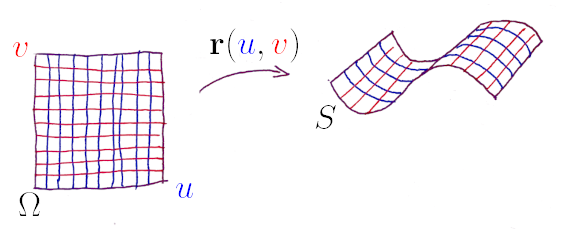Surface integral
Say we have a surface in and a scalar field . We want to integrate over the surface .
Here is the differential surface area.
Since we are integrating a 2 dimensional surface in 3 dimensional space, let’s parametrize with a function . takes a point in the region of the plane and projects it onto the 3 dimensional surface .

Imagine breaking up into square pieces, each of some area . When the corresponding region is projected onto , the area is distorted. If we hold one variable (say, ) constant and vary the other one by some small we will get a small vector that we will call . Likewise, for a small change we get . These two vectors form a parallelogram in . The area on that corresponds to our differential area on is then the area of the parallelogram formed by the two vectors and . Recall that the magnitude of the cross product of two vectors is the area of the parallelogram they form, so we can write this are as .
is one way to write the partial derivative of the function with respect to . It means the same thing as .
We can now write our integral in terms of and :
Over a vector field
The integral we just discussed was over a scalar field , but we can just as easily compute one for . In this case, we want to integrate the dot product of with the outwards pointing normal vector .
Note that since is normal to the surface, it must be perpendicular to both and . Therefore the direction of is just the cross product . Since is a unit vector, we need to divide by the norm, finally giving us .
Now we can set and use the surface integral formula above.
We almost always (unless otherwise noted) want the normal vector on a closed surface to point out. If your normal is pointing the wrong way you can either change the order of the cross product or just add a negative.